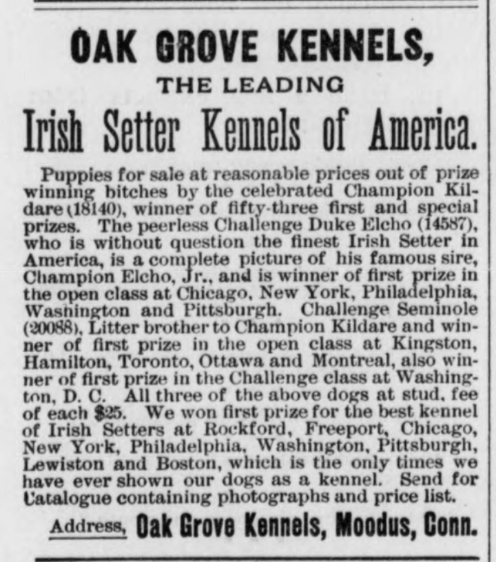We pick up where we left off in Part One with Mr. Washington having purchased the five year old champion Irish setter Dick Swiveler. The dog was entered in Chicago in February 1892 but not shown:

Dick was shown the following week but there was no glory in the win as far as The Fanciers’ Journal was concerned:


Some months later, Dick was sold again, this time to Dr. Frank Chester (F. C. ) Fowler of Oak Grove Kennels in Connecticut. The sale was widely reported:



Forest and Stream characterized the sale in benevolent terms in its September 29, 1892 issue:

Dr. Fowler was, shall we say, an interesting character and has a short profile in the 2018 book Wicked, Weird and Wily Yankees by Stephen Gencarella:

Snippets from the following editorial on Irish Setters appear to cast aspersions on Mr. Covert of Chicago, Mr. Washington of Pittsburgh and Dr. Fowler (see above ad) – all men who owned Dick Swiveler at different times:






By the end of the year, Dr. Fowler sold Dick to Alexander Bernard Truman of San Francisco. It’s worth noting that each time a dog was sent to a show or sold to a new owner, he was shipped by train. It was by all accounts a miserable way for a dog to travel. Dogs were often reported getting sick after being shipped. A number of dogs died on the train cars from suffocation or neglect (imagine how lost airline luggage fares in modern times). Dick would have spent a considerable amount of his life in a shipping box on a train.


Like Mr. Covert, Mr. Truman dedicated himself to grandiose claims of superiority in advertising Dick Swiveler, which irked some and led to yet another controversy in print:




Mr. Truman’s response:









Mr. Washington, one of Dick’s former owners, diplomatically offered some history and explanation:




Mr. Truman continued to show Dick over the next few years in California:


An article on the same show appeared in The Los Angeles Times on April 19, 1894 and provides some flavor of show life from the dogs’ perspective:




I include this snippet for a bit more flavor of the era’s dog shows and because I like to picture Dick cheerfully holding court from his stall during his long days. He was a winner at this show and, I hope, happy:

Dick Swiveler was found dead, reportedly poisoned, in his kennel in early December 1898. He was twelve years old. His death was noted on the front page of The New York Times:

Every notice of Dick’s death contained an incorrect birth year, including The New York Times’.




The Breeder and Sportsman and The Turf, Field and Farm were both particularly cruel in commenting on Dick’s death:


Was Dick Swiveler intentionally poisoned? I don’t believe anyone alive can say. But poisoning was very commonly claimed as a cause of dog deaths during this time. It was often attributed to a nefarious individual, colorfully referred to as “The Poison Fiend” in the weeklies, who purposely fed poison to dogs. It must be noted however that most canine veterinary medicine during this period was DIY and at-home remedies which included ingredients such as mercury, strychnine and other poisons, were regularly printed in the papers and passed along by word of mouth. In addition, dog catchers in some of the cities were tossing poisoned food out to strays on the streets, although the food was supposed to be picked up if not promptly eaten. Opportunities for accidental poisoning certainly existed but my impression is that poisoning was blamed far more often than it actually occurred. Intentional poisoning by a fiend was probably rare. In any case, it was an agonizing way to die.
In Memoriam: Dick Swiveler

In addition to Dick’s lengthy list of bench show wins, he produced some notable Irish setters including Ch. Mike Swiveler T and Ch. Lady Swiveler, a best in show winner (although before the award of that name existed, winning the W. R. Hearst Cup for best dog in show at the second San Francisco Kennel Club show) and dam to field trial winner Lady Finglas.

Amidst the human ambition, the jealousy and the ego was a dog. His name was Dick Swiveler and he was an Irish setter. He likely possessed the affectionate and happy disposition common to his breed. He had a beautiful outline. He neither knew nor cared about blue ribbons, newspaper gossip or money. Like all dogs, he simply wanted to love and be loved. I hope he was. I’m sorry that he died alone and hope his suffering was brief. To me, his memory is a blessing.

You are remembered with love, Dick Swiveler.

This is a wonderful pair of articles — fine writing & highly original research. You should write a book!
Thanks for the kind words and encouragement.
Dick looks and sounds like a lovely dog. I’m not so sure about his people–his many people, since he seems to have changed hands frequently. Was that normal at the time?
Yes, it was. Of course there were some who held onto a dog for life but many who continually bought and sold. And then there’s Dr. Jarvis, who had a big show winner in Elcho Jr and used him as his personal hunting dog then sold him in the last months of his life. He died in an unfamiliar place with dogs and people who were strangers to him. At least he didn’t get put on the auction block.
Oh, that’s really sad about Elcho Jr! Not right at all. 😕